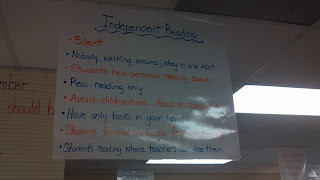At the school where I teach, the climate and culture of our building is truly family-like. Classes have either daily or weekly Community Meetings where ideas are shared, problems are discussed and solved, and appreciations are made. We foster the idea that we are all one community or family, and we need to take care of each other.
We continually refer to this community idea throughout the day, whether when working through class-wide issues or when working through individual issues. For example, when a child is loud or disruptive, one of the questions we may ask her individually is, "How do you think your actions may be affecting your community members?" We want the students to move beyond just thinking about their individual needs and also think about the needs of the community.
I had a student years ago who I frequently wanted to bound and gag. BUT, this student also could make me laugh and laugh and laugh! He had a hysterical personality! I was sure he would grow up to be a comedian; however, he recently wrote me the sweetest letter as he was graduating high school and indicated he was going into college to be an accountant! Reeeeaaaaallly? Wow! Awesome stuff!
Anyway, this little guy would always get in trouble in gym, which would affect the score that the class received. Every gym class, the class would get a score of 0 - 5, based on their collective, collaborative behavior. When someone continually got in trouble, that score would go down. At the time, I had a classroom marble jar, so if the students earned a four or five, they would get that many marbles in the jar. When the jar was full, we earned a reward. We did not put marbles in for a three or less, as it was not reflective of their personal best.
So, after weeks of students being frustrated, we called a Community Meeting to discuss the problem. During the meeting, the students used "I statements" to let this little guy know how they felt about their continual low score in gym due to his behavior choices. I heard things like:
"I feel frustrated when we all work hard, but our score goes down because you're goofing off."
"I feel sad that you don't seem to want to help us get a five at gym class."
"I feel confused because I know you can make better choices."
Keep in mind...these were 8-, 9-, and 10-year olds! They were not allowed to say anything negative about him...just tell him how they felt. He also had a chance to speak; although, he opted not to. We then went around our circle, and everyone brainstormed ideas of how we could help him in gym. We came up with a plan, he agreed to it, and wouldn't you know that his behavior in gym improved DRAMATICALLY!! Rarely did he get in trouble.
He saw how he was affecting his community, as well as how supportive his community was being to him despite the fact they were frustrated with him. He realized he was part of something bigger, and it wasn't just about himself, so he made a decision to make a change for the positive.
This past year, two students stole Sharpie markers and Highlighters from our classroom supply stash, and then went and sold them on the bus for $.25!! (Good gravy!) When we found out what was going on, Ruth (my teaching partner) and I didn't decide what consequence would happen to these two boys...our whole classroom community did! Because the boys technically stole from their community members, they wanted to have a say in what should happen. So, we had an emergency Community Meeting to discuss the issue.
Their collaborative consequences were so mature! The class decided the boys needed to be away from their community in a timeout room for a minimum of three days, they needed to fill out a reflection about what happened, and if possible, they needed to think of a way to get some of the Sharpies and Highlighters returned. They then actually helped us create the reflection the boys had to fill out, which consisted of questions such as:
1. Why did you feel it was okay to steal from our community?
2. How do you think we felt when we found out you stole from us?
3. How do you feel about your decision to steal?
4. What is something you could do if you ever felt like stealing again, either from us or from anyone?
5. What do you think would be a good consequence for what you did?
The students also agreed that they would NOT hold this over the boys' heads when their consequences were finished, and they would definitely forgive them, as we all make mistakes.
Now think about how much more powerful that was, versus a traditional punishment such as the students serving a week of detentions! They had to be accountable to 49 other students, they had to be reflective about their poor decision-making, and they had to be temporarily removed from their classroom community, where they were still responsible for doing school work!
Establishing a Classroom Community can not only help prepare students to be strong, contributing community members when they are adults, but it can help them begin seeing beyond their "self" lense. It can help build their understanding that they are part of something bigger, and their individual choices can impact others, both positively and negatively!
I'll post about how our Community Meetings run next! ;-)


